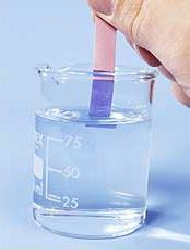| 1. 1 pts. |
When an alkali is mixed with an acid, neutralisation occurs because the — | |
| A. | base cools down | |
| B. | acid evaporates | |
| C. | base chemically reacts with the acid | |
| D. | mass of the solution increases | |
| 2. 1 pts. |
Complete the equation:… Magnesium + hydrochloric acid —> ……..+ water | |
| A. | Magnesium chlorate | |
| B. | Magnesium chloride | |
| C. | Magnesium chlorite | |
| D. | Magnesium hydrochloride | |
| 3. 1 pts. |
An alkali is able to “cancel” out an acid. What is the chemical name for cancelling out the acid? | |
| A. | nullify | |
| B. | annihalate | |
| C. | neutralise | |
| D. | overcome | |
| 4. 1 pts. |
In an experiment some pupils found that baking soda had a pH of about 9. Some people claim this substance can be used to treat bee stings. Bee stings must be | |
| A. | acid | |
| B. | alkaline | |
| C. | neutral | |
| D. | life threatening | |
| 5. 1 pts. |
What does this paper indicate?
|
||
| A. | The paper is nonreactive | ||
| B. | The liquid is acidic | ||
| C. | The liquid is water | ||
| D. | The liquid is alkaline | ||
| 6. 1 pts. |
Name the two products produced when hydrochloric acid neutralises magnesium hydroxide | |
| A. | sodium chloride and water | |
| B. | magnesium chloride and water | |
| C. | sodium chloride and salt | |
| D. | magnesium chloride and salt | |
| 7. 1 pts. |
With what would you neutralise potassium hydroxide to produce potassium nitrate? | |
| A. | hydrochloric acid | |
| B. | sulphuric acid | |
| C. | nitric acid | |
| D. | citiric acid | |
| 8. 1 pts. |
Which alkali would be reacted with hydrochloric acid to form lithium chloride? | |
| A. | lithium hydorxide | |
| B. | sodium hydroxide | |
| C. | sodium chloride | |
| D. | lithium nitrate | |
| 9. 1 pts. |
A student reacted hydrochloric acid with sodium hydroxide, until the solution was neutral. Next she evaporated, the water from the beaker. She noticed that white crystals remained in the bottom of the beaker. The crystals were most likely… | |
| A. | alkali | |
| B. | acid | |
| C. | water | |
| D. | salt | |
| 10. 1 pts. |
A purple colour when using universal indicator indicates the solution is | |
| A. | neutral | |
| B. | acidic | |
| C. | alkali | |
| D. | blackcurrant juice | |
| 11. 1 pts. |
A yellow colour when using universal indicator tells you that the solution must be a | |
| A. | strong alkali | |
| B. | weak alkali | |
| C. | neutral solution | |
| D. | weak acid | |
| E. | strong acid | |
| 12. 1 pts. |
What does lemon juice contain to make it acidic? | |
| A. | citiric acid | |
| B. | hydrochloric acid | |
| C. | baking soda | |
| D. | sodium hydroxide | |
| 13. 1 pts. |
A chemist wanted to make a compound called sodium citrate. How might she go about doing this? | |
| A. | neutralise sodium hydroxide with hydrochloric acid then add lemon juice | |
| B. | react citric acid with hydrochloric acid | |
| C. | react citric acid with magnesium hydroxide | |
| D. | react citric acid with sodium hydroxide | |
| 14. 1 pts. |
Milk of magnesia is a medicine used to treat indigestion. Milk of magnesia is most likely to be | |
| A. | alkali | |
| B. | neutral | |
| C. | from a cow | |
| D. | acidic | |
| 15. 1 pts. |
The pH of the stomach juices is most likely to be | |
| A. | 2 | |
| B. | 5 | |
| C. | 7 | |
| D. | 9 | |
| E. | 11 | |

